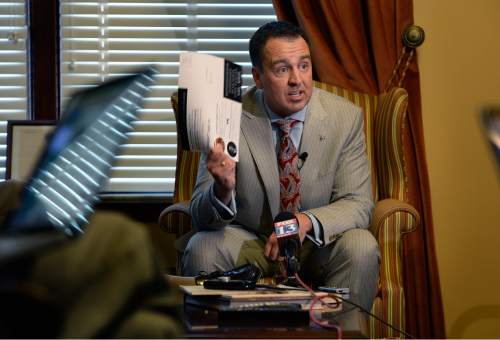This is an archived article that was published on sltrib.com in 2015, and information in the article may be outdated. It is provided only for personal research purposes and may not be reprinted.
House Speaker Greg Hughes is letting the governor's Healthy Utah plan be heard after all by a House committee, but it will go head-to-head with an alternative Medicaid expansion plan proposed by Hughes' second-in-command, Majority Leader Jim Dunnigan.
SB164 passed the Senate last week but Hughes has insisted it would be a waste of the House's precious time in the waning days of the session.
On Tuesday, however, he said that strategy did not produce the result he wanted, which was an agreement with Gov. Gary Herbert and Shiozawa on a more modest Medicaid expansion plan.
"All along, we thought there could be common ground," Hughes said. "There isn't that consensus. We think there are two plans that can be presented and judged."
Herbert, who last week began talking of leaving the Utah State Prison in Draper — Hughes' district — after all, applauded Hughes' change of heart, and pointed to public outcry rather than his own actions as the reason Hughes changed his mind.
"He's hearing the cries out there that say, 'Let us weigh in on it,'" Herbert said.
Herbert insisted that Healthy Utah 2.0 — the name given his proposal after the Senate approved a two-year pilot — is still the better plan, but said Dunnigan's Utah Cares is "a step in the right direction."
According to a handout from the House, Dunnigan's proposal has two parts: Medicaid for some low-income Utahns and an expanded Primary Care Network for others.
Utah Cares would provide Medicaid to about 22,000 low-income Utahns in 2016 and 32,000 in 2017. That would cost the state $63 million for the two years, and bring about $162 million from the feds, according to the estimates prepared by Legislative Research, working with the Utah Department of Health.
The Primary Care Network, which already provides coverage for about 18,000 Utahns, would get a bigger budget so it could serve 24,500 more in 2016, rising to 43,000 more in 2017. That piece would cost the general fund $23 million for the two years and in 2016 would bring in $57 million in federal money.
"Utah Cares is sustainable," Dunnigan said. "It's really a good step forward."
One option might be to adopt Utah Cares for 18 months, clarify some uncertainties, ask the federal government for more flexibility — and a more favorable funding match rate — "and then morph into Healthy Utah," Dunnigan said.
Dunnigan is also the House sponsor on Healthy Utah, but said, "I wouldn't read too much into that." He and Shiozawa have been working together on Medicaid expansion for more than a year, and Shiozawa asked him to co-sponsor the bill, Dunnigan said.
Healthy Utah would cover 89,000 people in the first year and 126,500 in the second. It would cost the state $1.8 million in the first year and $23.6 million in the second year, while bringing back to Utah nearly $946 million over two years that Utahns are paying in Affordable Care Act-related taxes.
Those estimates were prepared by the Utah Department of Health and the governor's office of management and budget.
"I'm here to tell you, as you analyze the costs … and the benefits for the Utah taxpayer and the people of Utah, Healthy Utah is absolutely the best plan," Herbert said.
The governor said Utah Cares would cover less than half as many people — 42,000 the first year and 57,000 the second — as Healthy Utah, and would cost the state $32 million in the first year and $45 million in the second. The state would be getting back $195 million from the federal government, the governor said.
But Dunnigan insisted Tuesday that Utah Cares would cover essentially the same number of people — but some of them via health insurance plans subsidized by the federal government on its marketplace.
In exchange for getting the Obama administration to agree to pay 100 percent of Utah's Medicaid expansion costs in the early years, Herbert agreed to extend Healthy Utah to an estimated 32,000 who already qualify for subsidies.
Under Dunnigan's plan, the feds will pay 70 percent and Utah will pick up 30 percent.
Dunnigan said HB446, with its PCN expansion, would take care of all those in the coverage gap — people who earn too much to qualify for Medicaid coverage but too little to qualify for federal subsidies to help them buy private insurance.
Under Healthy Utah, PCN would be phased out because low-income Utahns all would qualify for traditional or expanded Medicaid.
Started in November 2001, PCN provides preventive care on a first-come-first-served basis for those who earn up to 95 percent of the federal poverty level but don't qualify for traditional Medicaid. It mainly serves non-disabled adults who don't have children.
The Utah Department of Health typically has enough money to cover 18,000 to 19,000 Utahns in the network each year, according to Nate Checketts, health reform coordinator. The department opens and closes enrollment based on whether there's money available.
PCN is often described as bare-bones because it allows recipients to see their primary care physicians for preventive care and illnesses, but does not pay for visits to specialists or for hospitalization. PCN will pay for no more than four prescriptions a month, and only those emergency room visits that are truly emergencies.
Twitter: @KristenMoulton



